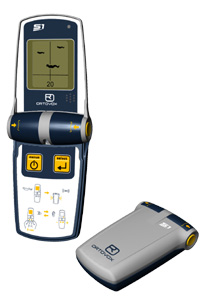
It has been a long wait for the Ortovox S1 but it seems to have been worth it. Supplies of this revolutionary avalanche transceiver are slowly making it into the shops. Original slated for the start of the 2005/2006 season the S1 is 18 months late. Development beset by a number of problems and Ortovox’ desire to get things right. When we tested a sample of the S1 in January 2006 it seemed to live up to its promise of simplifying the search process, especially when there is more than one victim.

To recap the S1 presents a graphical representation of the search area. A cross hair at the bottom of the display shows the searcher’s current location and victims within range are indicated by body icons. The range to the closest victim is given. To locate the first victim the searcher navigates until the icon is on the center line of the display then walks until the cross hairs are directly over the victim. What is perhaps slightly counter intuitive is that you will walk around an arc (following an elipsoid flux line) to do this while the display indicates that you are walking in a straight line. Once within 3 meters of the victim the display changes to show a concentric circle and you are in fine search mode. Moving in grid pattern over the victim you will see the diameter of the circle decrease as well as a distance reading displayed. Once you have localized the victim and marked with a probe you can eliminate his signal from the search without having to dig down and turn off his beacon. This greatly simplifies this part of the search phase. What is actually happening is that the Ortovox S1’s digital signal processor can differentiate between beacons because manufacturers use slightly different signals when transmitting (duty cycle) and beacons in the search zone from the same manufacturer are going to be slightly out of phase with different signal strengths depending on the distance to the victim. It is possible, and this has happened in tests, that one beacon can mask another where they are in proximity or obstacles can produce “ghost” victims and this is something to bear in mind when searching with one of these devices.
Beacon expert Halstead Morris has recently posted his experiences of the S1. During his tests he didn’t notice any priority given to “digital” beacons. Although all current beacons transmit on the international 457KHz frequency older analogue circuits such as the Ortovox F1 can drift. To a receiving beacon this looks like a weaker signal, digital beacons will prioritize stronger signals, potentially locking onto beacons which are physically further away. To overcome this, the receiving circuitry can be designed with a wide bandwidth but this reduces range and accuracy. The S1 is able to search for up to four beacons simultaneously. This is probably a software and processor limitation. Anymore and the beacon would be overwhelmed with information. However if there are more than 4 victims the beacon has a secondary search feature which reduced the search range to a 5 meter strip, excluding beacons outside this area. Halstead found the flagging feature to work efficiently even where beacons were in close proximity. He also found the fine grid searches to be very accurate, the S1’s three antennas doing a good job of sorting out the confusing mass of intersecting flux lines close to the victim.
Halstead did find the processor to be a bit slow at updating the display. This is a problem that besets all the digital beacons on the market, in order to operate for 200 hours on a couple of 1.5 volt batteries computer chips must be run slowly. The new Tracker II, scheduled for the start of the 2007/8 season will operate in real time. It may not sound like much of an issue but in the heat of a search it is easy to outrun a beacon by rapid movements and this can lead to confusion. The Ortovox S1 displays a flat hand indicating that you should stop while it tries to catch up. Also, if you move the beacon up and down too much an alarm will sound reminding you to keep the device horizontal and at the same distance to the ground. Halstead reports that the beacon could take 12-15 seconds to catch up. A representative from Ortovox told us that a software update is scheduled for the autumn and that all current Ortovox’s will be recalled.
The review suggests that the Ortovox could be the ideal beacon for group leaders. It has good range and would let the leader coordinate a search and rescue, sending groups off in the direction where the S1 indicates they are buried. Of course the ideal is not to have multi-victim searches by observing safe travel procedures but this is not always practical with larger groups or when climbing. The S1 has an electronic compass, thermometer and inclinometer. The inclinometer is handy for slope sighting and the compass could be useful in an emergency at the expense of battery life. The beacon will revert to transmit if it has not been moved for a preprogrammed time or by closing the case. This seems like an excellent idea.
The S1 is certainly a powerful transceiver showing just what can be done with multiple antennas and a good digital brain. However the price is steep, around the 450 euro/500 dollar mark. That’s double what you would pay for a BCA Tracker. The Tracker may not have all the bells and whistles but it will find single victims quickly and has a multivictim mode that works well. The S1 also looks slightly less revolutionary now that the Barryvox Pulse is out and has been on the market for the whole of the 2007/8 season. We would also wait for the scheduled software update and maybe the whole of the season to see what bugs, if any, come out.